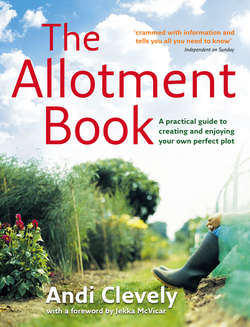Читать книгу The Allotment Book - Andi Clevely - Страница 47
MAKING A HOT BED
ОглавлениеFresh manure or green waste heats up as it decays. A hot bed can use this warmth to help raise early crops and provide extra growing space later in the season. If you can get a load of fresh farmyard manure or make a new compost heap in late winter, pack the material inside a timber container (old pallet boards are ideal). Adding moist tree leaves to the manure helps to moderate the initial surge of heat and the subsequent cooling. Cover and leave to warm up for two weeks.
Spread a 10–15cm (4–6in) layer of sieved soil over the heap, and top with a portable cold frame. Sow this with early radishes and carrots or turnips in rows, interplanted with young lettuces started in early winter. Pull the radishes 3–4 weeks later, leaving the lettuces to finish bulking up. When these are cleared, replace with summer cauliflower plants, and finally thin the carrots or turnips. All should be harvested in time to plant courgettes, marrows or cucumbers for summer. In the autumn, clear the plants and empty the entire contents of the hot bed for digging in.
Tools Good tools help to make light work of the allotment routine. Buy the best, use them sensitively and maintain them well, and they could give a lifetime’s service; regular use will condition them until they are comfortable and familiar, like an old gardening jacket or pair of boots.
CHOOSING TOOLS Buying cheap tools is a false economy, as they rarely perform well or last long, and the experience could disillusion you. Go for top quality, and be prepared to spend money; handle the tool before buying (never buy unseen), and ask advice if you are in doubt. Test it for size, weight and balance: you need to be confident about possibly using it for long periods without tiring. Consider the materials the tool is made from. An expensive stainless steel spade is easier to use and to clean when digging clay, for example, but might be unjustifiably costly if your soil is light and sandy; a round-tined rake is more durable in stony soil than one with flat pressed tines; a trowel with a brightly painted handle is easier to find in undergrowth.
